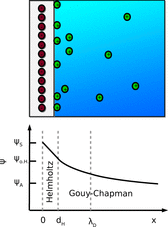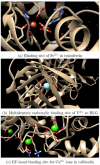Multivalent ions and biomolecules: Attempting a comprehensive perspective
- PMID: 32406605
- PMCID: PMC7496725
- DOI: 10.1002/cphc.202000162
Multivalent ions and biomolecules: Attempting a comprehensive perspective
Abstract
Ions are ubiquitous in nature. They play a key role for many biological processes on the molecular scale, from molecular interactions, to mechanical properties, to folding, to self-organisation and assembly, to reaction equilibria, to signalling, to energy and material transport, to recognition etc. Going beyond monovalent ions to multivalent ions, the effects of the ions are frequently not only stronger (due to the obviously higher charge), but qualitatively different. A typical example is the process of binding of multivalent ions, such as Ca2+ , to a macromolecule and the consequences of this ion binding such as compaction, collapse, potential charge inversion and precipitation of the macromolecule. Here we review these effects and phenomena induced by multivalent ions for biological (macro)molecules, from the "atomistic/molecular" local picture of (potentially specific) interactions to the more global picture of phase behaviour including, e. g., crystallisation, phase separation, oligomerisation etc. Rather than attempting an encyclopedic list of systems, we rather aim for an embracing discussion using typical case studies. We try to cover predominantly three main classes: proteins, nucleic acids, and amphiphilic molecules including interface effects. We do not cover in detail, but make some comparisons to, ion channels, colloidal systems, and synthetic polymers. While there are obvious differences in the behaviour of, and the relevance of multivalent ions for, the three main classes of systems, we also point out analogies. Our attempt of a comprehensive discussion is guided by the idea that there are not only important differences and specific phenomena with regard to the effects of multivalent ions on the main systems, but also important similarities. We hope to bridge physico-chemical mechanisms, concepts of soft matter, and biological observations and connect the different communities further.
Keywords: biomolecules; biophysical chemistry; charge-mediated interactions; multivalent ions; phase behaviour.
© 2020 The Authors. Published by Wiley-VCH Verlag GmbH & Co. KGaA.
Conflict of interest statement
The authors declare no conflict of interest.
Figures







Similar articles
-
Dynamics of Ionic Interactions at Protein-Nucleic Acid Interfaces.Acc Chem Res. 2020 Sep 15;53(9):1802-1810. doi: 10.1021/acs.accounts.0c00212. Epub 2020 Aug 26. Acc Chem Res. 2020. PMID: 32845610 Free PMC article.
-
Electrostatics of strongly charged biological polymers: ion-mediated interactions and self-organization in nucleic acids and proteins.Annu Rev Phys Chem. 2010;61:171-89. doi: 10.1146/annurev.physchem.58.032806.104436. Annu Rev Phys Chem. 2010. PMID: 20055668 Review.
-
Multivalent ions control the transport through lysenin channels.Biophys Chem. 2010 Nov;152(1-3):40-5. doi: 10.1016/j.bpc.2010.07.004. Epub 2010 Aug 3. Biophys Chem. 2010. PMID: 20724059
-
Understanding nucleic acid-ion interactions.Annu Rev Biochem. 2014;83:813-41. doi: 10.1146/annurev-biochem-060409-092720. Epub 2014 Mar 5. Annu Rev Biochem. 2014. PMID: 24606136 Free PMC article. Review.
-
Electrostatic Correlation Induced Ion Condensation and Charge Inversion in Multivalent Electrolytes.J Chem Theory Comput. 2022 Oct 11;18(10):6271-6280. doi: 10.1021/acs.jctc.2c00607. Epub 2022 Sep 22. J Chem Theory Comput. 2022. PMID: 36136891
Cited by
-
Electrostatic Interactions in the Formation of DNA Complexes with Cis- and Trans-Isomers of Azobenzene-Containing Surfactants in Solutions with Di- and Trivalent Metal Ions.ACS Omega. 2023 Apr 14;8(16):14597-14609. doi: 10.1021/acsomega.3c00419. eCollection 2023 Apr 25. ACS Omega. 2023. PMID: 37125131 Free PMC article.
-
Continuity of Short-Time Dynamics Crossing the Liquid-Liquid Phase Separation in Charge-Tuned Protein Solutions.J Phys Chem Lett. 2024 Dec 5;15(48):12051-12059. doi: 10.1021/acs.jpclett.4c02533. Epub 2024 Nov 26. J Phys Chem Lett. 2024. PMID: 39589726
-
Interaction among bovine serum albumin (BSA) molecules in the presence of anions: a small-angle neutron scattering study.J Biol Phys. 2022 Jun;48(2):237-251. doi: 10.1007/s10867-022-09608-w. Epub 2022 Apr 13. J Biol Phys. 2022. PMID: 35416637 Free PMC article.
-
Effects of Ionic Liquids on Metalloproteins.Molecules. 2021 Jan 19;26(2):514. doi: 10.3390/molecules26020514. Molecules. 2021. PMID: 33478102 Free PMC article. Review.
-
Enhanced protein adsorption upon bulk phase separation.Sci Rep. 2020 Jun 25;10(1):10349. doi: 10.1038/s41598-020-66562-0. Sci Rep. 2020. PMID: 32587383 Free PMC article.
References
-
- Messina R., J. Phys. Condens. Matter 2009, 21, 113102. - PubMed
-
- Barrat J.-L., Joanny J.-F., Adv. Chem. Phys. 1996, 94, 1–66.
-
- Smiatek J., Molecules 2020, 25, 1661.
-
- Jönsson B., Wennerström H., J. Adhes. 2004, 80, 339–364.
-
- Kunz W., Curr. Opin. Colloid Interface Sci. 2010, 15, 39–39.
Publication types
MeSH terms
Substances
Grants and funding
LinkOut - more resources
Full Text Sources
Miscellaneous

